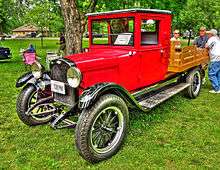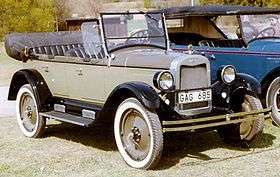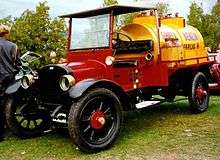Chevrolet Superior
The Chevrolet Superior was launched in 1923, manufactured by Chevrolet for four years with a different series per year. The 1923 model was known as the Series B, the 1924 model was the Series F, for 1925 it was known as the Series K and the 1926 Superior was known as the Series V. It was replaced in 1927 by the Series AA Capitol.

| Chevrolet Superior | |
|---|---|
 1926 Chevrolet Superior Series V Touring | |
| Overview | |
| Manufacturer | Chevrolet (General Motors) |
| Model years | 1923-1926 |
| Assembly | Oakland Assembly, Oakland, California North Tarrytown Assembly, Tarrytown, New York Flint Assembly, Flint, Michigan Norwood Assembly, Norwood, Ohio St. Louis Assembly, St. Louis, Missouri Arlington Assembly, Arlington, Texas Oshawa Assembly, Oshawa, Ontario Canada |
| Body and chassis | |
| Platform | GM A platform |
| Related | Oakland Pontiac (1926) |
| Powertrain | |
| Engine | 171 cu in (2.8 L) 4-cylinder |
| Transmission | 3-speed manual |
| Dimensions | |
| Wheelbase | 103 in (2,616.2 mm) |
| Length | 146.06 in (3,709.9 mm)[1] |
| Width | 44.16 in (1,121.7 mm) |
| Curb weight | 1,690–2,070 lb (767–939 kg) (Series K) |
| Chronology | |
| Predecessor | Chevrolet Series 490 |
| Successor | Chevrolet Series AA Capitol |
All Superior models were powered by a 171 cu in (2.8 L) 4-cylinder engine, 26 hp @ 2000 rpm, and shared the 103 in (2,616.2 mm) wheelbase. The cheapest complete model, which was the Superior Roadster, cost $510 in 1926, while the range-topping model, the Superior Sedan, sold for $825. It was also possible to buy a chassis; the Commercial chassis cost $425, while the Express Truck chassis cost $525.
GM Platform sharing
This chassis was shared with other GM products at the time, including Cadillac, Buick, Oldsmobile, Oakland and GMC products, introducing the "A-body", "B-body" and "C-body". This policy of sharing mechanicals across multiple brand led to the General Motors Companion Make Program in the 1920s. Starting with leadership under Mr. Sloan, GM instituted visual styling changes for each yearly series.
 1921 Cadillac Suburban
1921 Cadillac Suburban 1923 Buick Master
1923 Buick Master 1922 Oldsmobile
1922 Oldsmobile 1923 Oakland
1923 Oakland 1919 GMC
1919 GMC
See also
References
Source: Slauson, H. W.; Howard Greene (1926). ""Leading American Motor Cars"". Everyman’s Guide to Motor Efficiency. New York: Leslie-Judge Company.
| Wikimedia Commons has media related to 1926 Chevrolet automobiles. |
| Wikimedia Commons has media related to Chevrolet trucks. |
| Wikimedia Commons has media related to GMC trucks. |